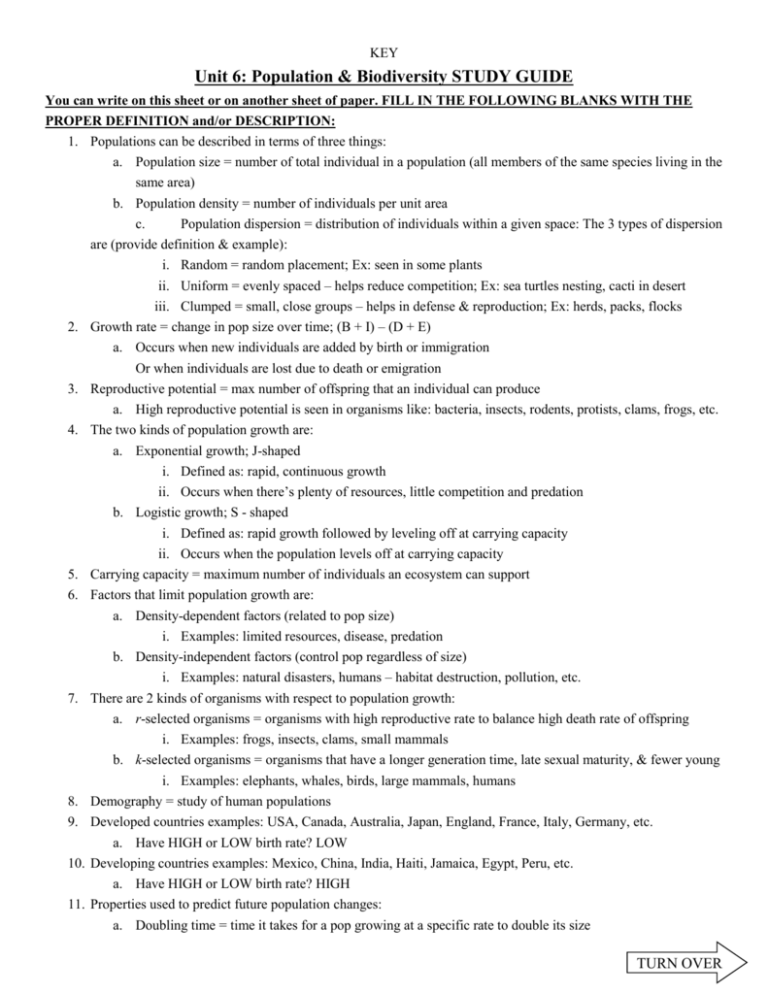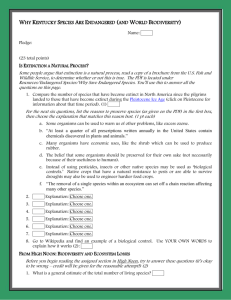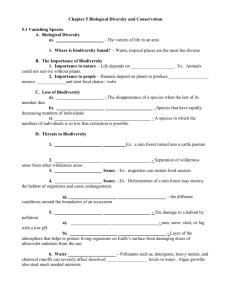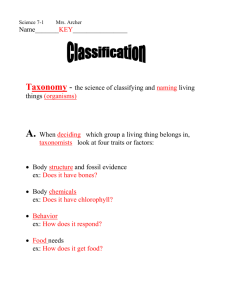Population & Biodiversity Study Guide
advertisement

KEY Unit 6: Population & Biodiversity STUDY GUIDE You can write on this sheet or on another sheet of paper. FILL IN THE FOLLOWING BLANKS WITH THE PROPER DEFINITION and/or DESCRIPTION: 1. Populations can be described in terms of three things: a. Population size = number of total individual in a population (all members of the same species living in the same area) b. Population density = number of individuals per unit area c. Population dispersion = distribution of individuals within a given space: The 3 types of dispersion are (provide definition & example): i. Random = random placement; Ex: seen in some plants ii. Uniform = evenly spaced – helps reduce competition; Ex: sea turtles nesting, cacti in desert iii. Clumped = small, close groups – helps in defense & reproduction; Ex: herds, packs, flocks 2. Growth rate = change in pop size over time; (B + I) – (D + E) a. Occurs when new individuals are added by birth or immigration Or when individuals are lost due to death or emigration 3. Reproductive potential = max number of offspring that an individual can produce a. High reproductive potential is seen in organisms like: bacteria, insects, rodents, protists, clams, frogs, etc. 4. The two kinds of population growth are: a. Exponential growth; J-shaped i. Defined as: rapid, continuous growth ii. Occurs when there’s plenty of resources, little competition and predation b. Logistic growth; S - shaped i. Defined as: rapid growth followed by leveling off at carrying capacity ii. Occurs when the population levels off at carrying capacity 5. Carrying capacity = maximum number of individuals an ecosystem can support 6. Factors that limit population growth are: a. Density-dependent factors (related to pop size) i. Examples: limited resources, disease, predation b. Density-independent factors (control pop regardless of size) i. Examples: natural disasters, humans – habitat destruction, pollution, etc. 7. There are 2 kinds of organisms with respect to population growth: a. r-selected organisms = organisms with high reproductive rate to balance high death rate of offspring i. Examples: frogs, insects, clams, small mammals b. k-selected organisms = organisms that have a longer generation time, late sexual maturity, & fewer young i. Examples: elephants, whales, birds, large mammals, humans 8. Demography = study of human populations 9. Developed countries examples: USA, Canada, Australia, Japan, England, France, Italy, Germany, etc. a. Have HIGH or LOW birth rate? LOW 10. Developing countries examples: Mexico, China, India, Haiti, Jamaica, Egypt, Peru, etc. a. Have HIGH or LOW birth rate? HIGH 11. Properties used to predict future population changes: a. Doubling time = time it takes for a pop growing at a specific rate to double its size TURN OVER 12. 13. 14. 15. 16. 17. 18. 19. 20. 21. 22. b. Fertility rate = number of babies born each year per 1,000 women; high in developing countries c. Migration = movement into an area d. Age structure = distribution of ages in a country i. Developing countries’ age structure diagrams look like pyramid/ triangle ii. Developed countries’ age structure diagrams look like rectangles; more even among age classes Demographic Transition = model that shows the effects of economic and social changes on a population’s birth and death rates Current human population ~ 7 billion a. What affects a country’s population growth: i. Type of economy ii. Status of WOMEN iii. Cultural beliefs such as the importance of sons iv. Religious beliefs b. Problems with human population growth include (name at least 5 problems): i. Resource depletion, esp. nonrenewable resources ii. Water & air pollution iii. Loss of farmable land iv. Loss of biodiversity v. Diseases c. Ways governments slow down population growth: advertising, family planning programs, economic incentives, legal punishments. Ex: China’s One-Child Policy; Thailand’s funny commercials Biodiversity: Number of species on Earth is estimated to be 10 million; actual number known is 1.7 million Biodiversity can be studied at three levels: a. Species diversity = number of different species in an area b. Ecosystem diversity = variety of habitats, communities, and ecological processes in an ecosystem c. Genetic diversity = all the different genes contained within the population’s gene pool Why is biodiversity important? (1) W dependent on healthy ecosystems to ensure balanced nutrient cycles; (2) we use a variety of organisms for food, clothing, shelter & medicine; (3) bioethics – some believe it’s the moral thing to do to save organisms; (4) aesthetic value & personal enjoyment High biodiversity can be found in tropical rain forests, coral reefs, coastal areas, and islands Biodiversity hotspots = have high numbers of endemic species and are threatened by humans a. Endemic species = species found only within a limited area Endangered species = species in immediate danger of extinction Threatened species = species who’s populations are declining Threats to biodiversity include: a. Habitat fragmentation and destruction b. pollution c. invasive species – not native to an area and causing problems d. overharvesting Solutions to the loss of biodiversity include: a. Captive breeding programs and zoos b. Important Law: Endangered Species Act of 1973 c. IUCN stands for: International Union for the Conservation of Nature and Natural Resources d. CITES stands for: Convention on International Trade in Endangered Species






